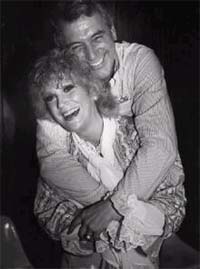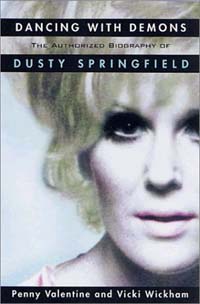 |
|
Dancing With Demons: The Authorized Biography of Dusty Springfield by Penny Valentine and Vicki Wickham; St. Martin's Press; 309 pages; $24.95.
"Unlike many of her British contemporaries, who usually sounded almost painfully English," wrote Thomas Ryan, "Springfield has a singing voice and style that fit right in with her American counterparts," not excluding Aretha Franklin. Between 1964 and 1967 Springfield recorded a series of records for Phillips that are now classics, and 1968's Dusty in Memphis (Atlantic Records) is considered one of the greatest albums of the age. Dancing With Demons, by Penny Valentine and Vicki Wickham, claims to be "the authorized biography of Dusty Springfield". This raised some eyebrows, since Springfield - who died of breast cancer in 1999 - had nothing to do with the making of this book. The critics were not convinced by the fact that Wickham "was Dusty's friend and manager for much of her career" or that Valentine "was the journalist closest to Dusty at the height of her fame." The authors explained their claim by noting that their book was "authorized" by Springfield's estate, and by her brother Tom Springfield. The book certainly enjoyed the cooperation of Dusty's friends and lovers; and the collaboration of "Dusty insider" Wickham gives the book an air of authenticity it would not have otherwise.
 "The story of Dusty is . . . both sad and uplifting. It's the story of a plain girl who became a lovely woman and a star, who hit the bottom, lost it all and then found success again late in her life - not because audiences felt nostalgic or sorry for her but because they thrilled, as they always had, to her voice. And it's the story of a survivor. However much she was emotionally or physically abused and however much she abused herself Dusty always retained her sense of humour and her old winning ways."
Dusty's devoted fans - of which there are still many - objected to Dancing With Demons's "warts and all" approach to their idol's life. Indeed, those of us who knew Springfield mainly through her music found this book's less-than flattering revelations to be quite disturbing. If all the revelations are true - and I have no reason to doubt them - then Springfield qualifies for "tragic diva" status along with the likes of Judy Garland and Billie Holiday.
"The story of Dusty is . . . both sad and uplifting. It's the story of a plain girl who became a lovely woman and a star, who hit the bottom, lost it all and then found success again late in her life - not because audiences felt nostalgic or sorry for her but because they thrilled, as they always had, to her voice. And it's the story of a survivor. However much she was emotionally or physically abused and however much she abused herself Dusty always retained her sense of humour and her old winning ways."
Dusty's devoted fans - of which there are still many - objected to Dancing With Demons's "warts and all" approach to their idol's life. Indeed, those of us who knew Springfield mainly through her music found this book's less-than flattering revelations to be quite disturbing. If all the revelations are true - and I have no reason to doubt them - then Springfield qualifies for "tragic diva" status along with the likes of Judy Garland and Billie Holiday.
Throughout her life, Dusty Springfield battled various "demons" that paradoxically made her a musical legend: "Emotionally fragile, Dusty was driven to succeed because her often-battered ego needed her audience to assure her she was loved at all." Born Mary Isobel Catherine Bernadette O'Brien, she grew up in a dysfunctional family that was notorious for throwing food at one another during dinners (a bad habit that Dusty would continue throughout her life). A devout Catholic, Dusty was troubled by her lesbianism, which was clearly at odds with the teachings of the Church. Throughout her professional life, Dusty remained in the closet, "terrified that her mainstream audiences would not love her, that the image she had spent so long building up would be shattered and the industry would cold-shoulder her."
Dusty also suffered from abusive and violent relationships - one of her girl friends hit her with a sauce pan, smashing her mouth and scarring her for life. Not till the mid-1980's did Springfield regain her momentum, returning to the charts with "What Have I Done to Deserve This?," a duet with the Pet Shop Boys. Ironically, it was only when Dusty was diagnosed with cancer in the early 1990's that she was finally able to put her demons behind her and deal with what was really important in her life. Though they will never convince the purists, there is no doubt that Valentine and Wickham loved Dusty Springfield when she was alive, and cherish her memory now that she's dead. Still, is was probably a mistake to dwell so much on Springfield's personal life, sometimes at the expense of the singer's musical genius. Dancing with Demons suffers from the lack of a Bibliography and a Discography, and from musical inaccuracies that are inexcusable in a singer's biography. Still, for all its faults, it is the best book written about Dusty Springfield, and will be the best book possible for a long time. Like Garland and Holiday before her, Springfield will remain part of our cultural heritage, not for her personal demons but for her God-given talents. Read the book, put it away, and then listen to Dusty in Memphis. This, my fellow music lovers, is the REAL Dusty Springfield.  Maria Callas: An Intimate Biography by Anne Edwards; St. Martin's Press; 342 pages; $27.95.
Maria Callas: An Intimate Biography by Anne Edwards; St. Martin's Press; 342 pages; $27.95.
Dusty Springfield, we agree, was a diva. Maria Callas was THE diva. Pop biographer Anne Edwards, famous for her lives of Princess Diana, Barbra Streisand and other famous women, tried her hand at the life of the singer and actor who was as (in) famous for her romantic entanglements and outsized temper as for her operatic genius. Though Edwards covers all the bases, her "intimate biography" does not reveal anything we haven't read before and is vastly inferior to Arianna Stassinopoulos's (later Huffington) effort. Still, there is enough juicy stuff here to make Maria Callas fun to read - at the beach or on "the throne".
|


 Dusty Springfield (1939-1999) was the rock era's first white diva. In her mid-1960's heyday, according to Bruce Eder, Dusty "made herself over vocally, evolving from a folk alto into a powerful, white soul singer, capable of credibly covering Motown material ... and belting out British pop numbers with seismic intensity."
Dusty Springfield (1939-1999) was the rock era's first white diva. In her mid-1960's heyday, according to Bruce Eder, Dusty "made herself over vocally, evolving from a folk alto into a powerful, white soul singer, capable of credibly covering Motown material ... and belting out British pop numbers with seismic intensity."
 Jesse Monteagudo is a freelance writer who lives in South Florida with
his domestic partner. He can be reached at
Jesse Monteagudo is a freelance writer who lives in South Florida with
his domestic partner. He can be reached at